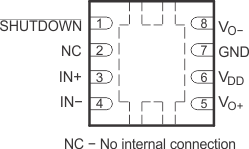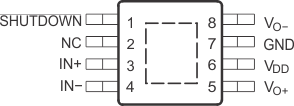SLOS369G July 2002 – October 2015 TPA2005D1
PRODUCTION DATA.
- 1 Features
- 2 Applications
- 3 Description
- 4 Revision History
- 5 Device Comparison Table
- 6 Pin Configuration and Functions
- 7 Specifications
- 8 Parameter Measurement Information
- 9 Detailed Description
- 10Application and Implementation
- 11Power Supply Recommendations
- 12Layout
- 13Device and Documentation Support
- 14Mechanical, Packaging, and Orderable Information
封装选项
请参考 PDF 数据表获取器件具体的封装图。
机械数据 (封装 | 引脚)
- DGN|8
- DRB|8
散热焊盘机械数据 (封装 | 引脚)
订购信息
6 Pin Configuration and Functions
GQY and ZQY Packages
15-Pin MicroStar Junior™
Top and Side Views

DRB Package
8-Pin VSON
Top View

DGN Package
8-Pin HVSSOP
Top View

A. The shaded terminals are used for electrical and thermal connections to the ground plane. All the shaded terminals need to be electrically connected to ground. No connect (NC) terminals still need a pad and trace.
B. The thermal pad of the DRB and DGN packages must be electrically and thermally connected to a ground plane.
Pin Functions
| PIN | I/O | DESCRIPTION | ||
|---|---|---|---|---|
| NAME | GQY, ZQY | DRB, DGN | ||
| GND | A2, A3, B3, C2, C3, D2, D3 | 7 | I | High-current ground |
| IN- | D1 | 4 | I | Negative differential input |
| IN+ | C1 | 3 | I | Positive differential input |
| NC | B1 | 2 | No internal connection | |
| SHUTDOWN | A1 | 1 | I | Shutdown terminal (active low logic) |
| Thermal Pad | Must be soldered to a grounded pad on the PCB. | |||
| VDD | B4, C4 | 6 | I | Power supply |
| VO- | A4 | 8 | O | Negative BTL output |
| VO+ | D4 | 5 | O | Positive BTL output |